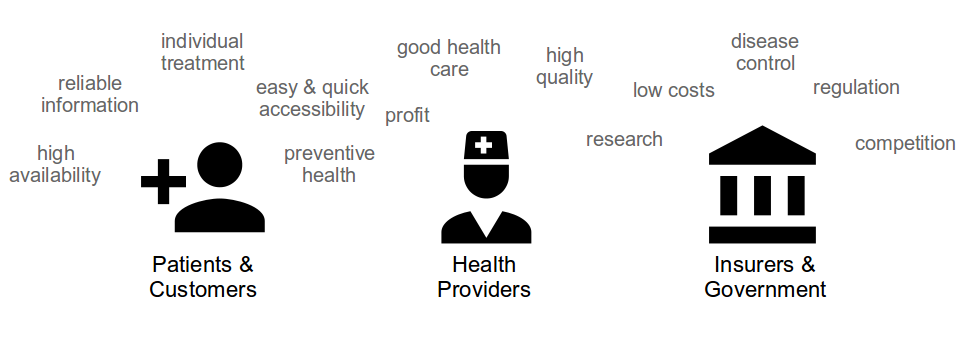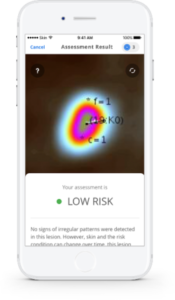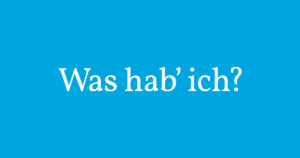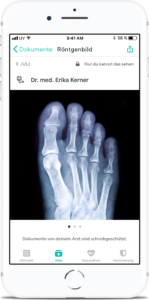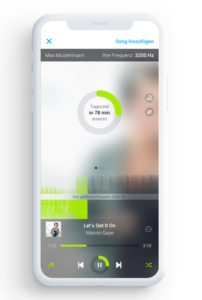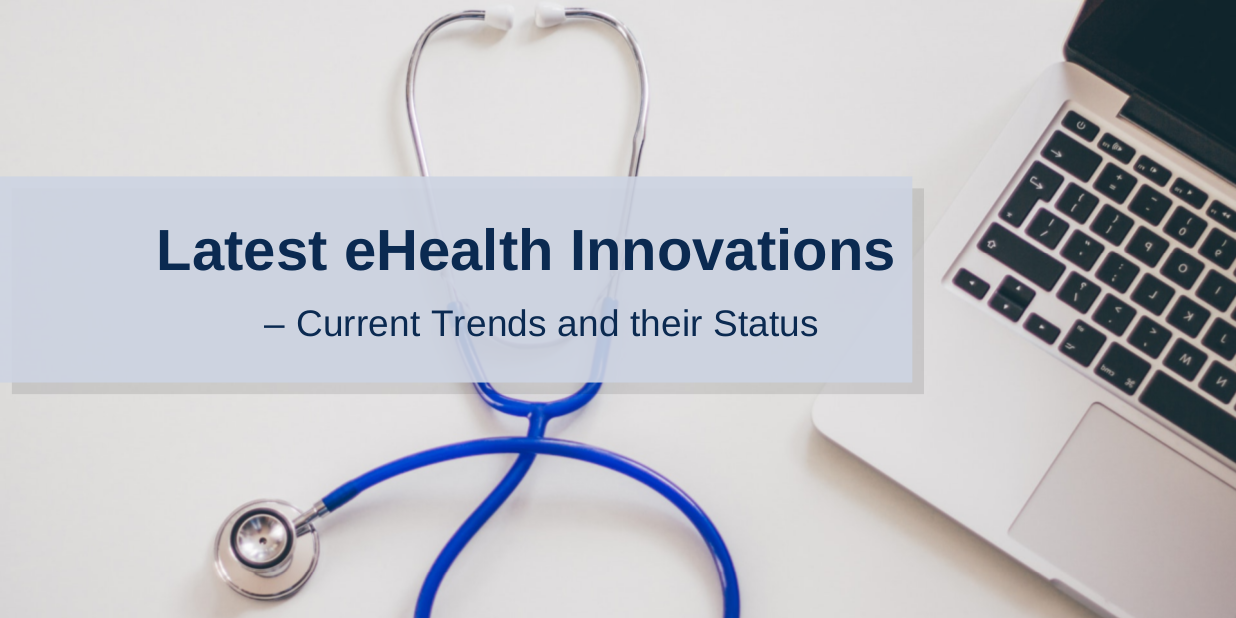(by Christoph Sager and Katja Winkler)
Within the first quarter of the 21st century, a continuous trend of small, innovative enterprises trying to enter established industries in the search for scalable business models for health interventions can be seen. This is also true for the health sector. Especially the occurrence of new technologies and ubiquitous devices like smartphones created unknown possibilities for startups to enter areas formally only open to medical experts.
Startups Discovering the eHealth Sector
A study by Ernst&Young published in January 2018 found young enterprises operating in the health sector to receive the third largest share of venture investment in Germany. This trend has a rapid momentum with investment almost doubling from €291m in 2016 to €522m in 2017 Life Sciences (€374m) and Digital Health (€113m), whereby the first was backed by a single Initial Public Offering of a medical research company.
Categorizing eHealth Innovations
The term eHealth covers various methods that use information and communication technology to improve health or enable health prevention over distance
What are the primary stakeholders of eHealth and who may be the main beneficiary of new information technologies? The customer , more specific the patient, will profit of enhanced and more comfortable treatment and health care health providers like hospitals, doctors or pharmacists. Lastly, the payment for the treatments needs to be clear. If the payer is not the patient, this responsibility falls to the government or some health insurance company . Besides the monetary part, governments are also in charge of establishing regulations and fostering research. For the simplicity, these two actors are put into one category (following the suggestions made by Lambooij and Hummel in
Figure 1: Representation of primary stakeholders in eHealth and their basic needs Figure 1 shows a selection of interests for each stakeholder and places them in between if there are overlapping interests. Proceeding with this information, the needs are categorized into four broader dimensions (Figure 2) which can serve as a classification of health innovations.
Figure 2: Categories for eHealth innovations derived from stakeholder needs Promises of Different Classes of eHealth
The oldest problems in digitization of health are missing standards or inconsistent information Health Information .
Ubiquitous devices like smartphones or small gadgets already contain lots of small sensors, which can collect health-related data quite accurately. This data can not only be used to monitor symptoms of known illnesses, but also to make diagnoses, which the users were not aware of before Diagnosis, therefore, represents the second category.
In addition to diagnosing of and informing about illnesses, is a machine also capable of curing a disease? This is a question to be answered by research in the upcoming years Treatment section, some start-ups are presented in the following.
The fourth category is Administration . The development of modern societies gave rise to an increasingly complex system of health coverage. For optimal outcome, collaboration and exchange of knowledge is needed. However, due to the lack of a secure infrastructure to exchange this knowledge, health providers so far are reluctant to the sharing of sensitive information. Nevertheless, a health information platform could be the foundation for innovators
Presenting Selected Health Innovations
The following section presents one selected innovation for each of the categories described above. Besides the description of each product, its utility is introduced.
Diagnosis: SkinVision
Skin cancer is a widespread disease, and lots of people develop moles that have to be checked regularly. Yet, appointments at dermatologists are rare and can be expensive. “SkinVision” is an app-based diagnosis tool (Figure 3) that tries to tackle this problem. Customers take a picture of their mole, and an algorithm is calculating the probability of cancer with a sensitivity of ~80% https://www.skinvision.com .
Health Information: Was hab’ ich?
Patients repeatedly have trouble understanding the professional language of doctors. Often health providers do not have the capacity to explain a diagnosis in an understandable way. “Was hab’ ich?” (German for “What do I have?”, Figure 4), a Dresden-based charitable company, translates medical reports free of charge into everyday language that is easy to understand for non-medic (only available for German). Students of medicine engage voluntarily in the translation, the website is funded by donations. The founders started the project after realizing that patients are increasingly interested in learning about their diseases and being engaged concerning the treatment. Further information is available at https://washabich.de/ .
The latest product of the organization is “Patientenbrief” (German for “patient letter”), which aims to create comprehensible discharge documents. The content explains the type of disease in simple terms and describes the treatment as well as what the patient should be doing after leaving the health facility.
Administration: Vivy
Electronic Health Records play an important role in eHealth innovations since some services rely on the connection of health stakeholders to exchange information. “Vivy” is the app of a German startup aiming to develop a solution for this problem (Figure 5). The company was selected in a public announcement of a collection of health insurers and is backed by Allianz, another private insurer. The application provides an interface to request medical documents and store them on the smartphone. Subsequently, it is possible to share the documents with doctors. Moreover, it provides features like a digital medication plan, a vaccination record and emergency details. More information can be found at https://www.vivy.com/ .
The platform is open to all medical partners and more than 25 million customers of cooperating health insurers are already able to use it. However, in August and October 2018 the application received a lot of criticism when security experts detected several vital security flaws in the system which could have potentially revealed sensible health data (Presentation at the 35C3 ). The operator announced in a public statement to have fixed the problems.
Treatment: Tinnitracks
In Germany, more than three million people suffer from tinnitus, which generates a constant ringing in the ears. “Tinnitracks” is a mobile application that treats chronic, tonal tinnitus with music (Figure 6). The so-called “Tailor-Made Notched Music Training” (TMNMT) is based on current findings in the neurosciences and aims to reduce the perceived tinnitus volume Sonormed , cooperates with public and private insurers that bear the costs for their customers, but the service is also available for direct payers. Find more information at www.tinnitracks.com/ .
Outlook
The use-cases and applications presented above show that eHealth services are present and can be a solution to many problems. Still, there exist some challenges that have to be addressed. So far, mainly two issues can be identified.
First, it is hard for users to assess the quality and scientific foundation of eHealth services. A solution can be audits and standards executed by public institutions or media sites testing and validating the applications. A more straightforward approach would be accessible and health research would be more transparent. Scientific studies build the base of most eHealth services and have already been peer-reviewed. Unfortunately, some of these papers are hard to find or hidden behind paywalls. It should be standard practice to report about the results of those studies in open access journals retrievable for everyone.
Another challenge concerning all services handling sensitive health data are security and privacy. Popular certificates for acknowledging data security already exist but security flaws have also been found in tested applications. Enforced best practices and standards could also improve this situation, like two-factor authentication (already mandatory in banking) or bug bounty programs (rewarding security hole reports). Additionally, cryptography can only ensure a temporary security, due to increasing computing power and new architectures. Decentralization could be considered for new systems processing eHealth data so that a directed hack would only reveal parts of the stored data.
All in all, a stable development of new promising health services using information and communication technologies can be seen.
Referenzen
{1908008:LHT5TQST};{1908008:9CM4DTCT};{1908008:R25B6382};{1908008:N9VVG2WM};{1908008:ZS768SJS};{1908008:I8DH4MP9};{1908008:3YS4E7MB};{1908008:R25B6382};{1908008:E3PDX286};{1908008:3WKVI3PS};{1908008:G6YE6XCW};{1908008:PZM7ZLLE};{1908008:WVVZFUXK} apa author asc no 1630
%7B%22status%22%3A%22success%22%2C%22updateneeded%22%3Afalse%2C%22instance%22%3A%22zotpress-bf751dca607fcdd06917bc51d342b0f4%22%2C%22meta%22%3A%7B%22request_last%22%3A0%2C%22request_next%22%3A0%2C%22used_cache%22%3Atrue%7D%2C%22data%22%3A%5B%7B%22key%22%3A%223YS4E7MB%22%2C%22library%22%3A%7B%22id%22%3A1908008%7D%2C%22meta%22%3A%7B%22creatorSummary%22%3A%22Berkman%20et%20al.%22%2C%22parsedDate%22%3A%222011-07-19%22%2C%22numChildren%22%3A0%7D%2C%22bib%22%3A%22%3Cdiv%20class%3D%5C%22csl-bib-body%5C%22%20style%3D%5C%22line-height%3A%202%3B%20padding-left%3A%201em%3B%20text-indent%3A-1em%3B%5C%22%3E%5Cn%20%20%3Cdiv%20class%3D%5C%22csl-entry%5C%22%3EBerkman%2C%20N.%20D.%2C%20Sheridan%2C%20S.%20L.%2C%20Donahue%2C%20K.%20E.%2C%20Halpern%2C%20D.%20J.%2C%20%26amp%3B%20Crotty%2C%20K.%20%282011%29.%20Low%20health%20literacy%20and%20health%20outcomes%3A%20an%20updated%20systematic%20review.%20%3Ci%3EAnnals%20of%20Internal%20Medicine%3C%5C%2Fi%3E%2C%20%3Ci%3E155%3C%5C%2Fi%3E%282%29%2C%2097%26%23x2013%3B107.%20%3Ca%20href%3D%27https%3A%5C%2F%5C%2Fdoi.org%5C%2F10.7326%5C%2F0003-4819-155-2-201107190-00005%27%3Ehttps%3A%5C%2F%5C%2Fdoi.org%5C%2F10.7326%5C%2F0003-4819-155-2-201107190-00005%3C%5C%2Fa%3E%3C%5C%2Fdiv%3E%5Cn%3C%5C%2Fdiv%3E%22%2C%22data%22%3A%7B%22itemType%22%3A%22journalArticle%22%2C%22title%22%3A%22Low%20health%20literacy%20and%20health%20outcomes%3A%20an%20updated%20systematic%20review%22%2C%22creators%22%3A%5B%7B%22creatorType%22%3A%22author%22%2C%22firstName%22%3A%22Nancy%20D.%22%2C%22lastName%22%3A%22Berkman%22%7D%2C%7B%22creatorType%22%3A%22author%22%2C%22firstName%22%3A%22Stacey%20L.%22%2C%22lastName%22%3A%22Sheridan%22%7D%2C%7B%22creatorType%22%3A%22author%22%2C%22firstName%22%3A%22Katrina%20E.%22%2C%22lastName%22%3A%22Donahue%22%7D%2C%7B%22creatorType%22%3A%22author%22%2C%22firstName%22%3A%22David%20J.%22%2C%22lastName%22%3A%22Halpern%22%7D%2C%7B%22creatorType%22%3A%22author%22%2C%22firstName%22%3A%22Karen%22%2C%22lastName%22%3A%22Crotty%22%7D%5D%2C%22abstractNote%22%3A%22BACKGROUND%3A%20Approximately%2080%20million%20Americans%20have%20limited%20health%20literacy%2C%20which%20puts%20them%20at%20greater%20risk%20for%20poorer%20access%20to%20care%20and%20poorer%20health%20outcomes.%5CnPURPOSE%3A%20To%20update%20a%202004%20systematic%20review%20and%20determine%20whether%20low%20health%20literacy%20is%20related%20to%20poorer%20use%20of%20health%20care%2C%20outcomes%2C%20costs%2C%20and%20disparities%20in%20health%20outcomes%20among%20persons%20of%20all%20ages.%5CnDATA%20SOURCES%3A%20English-language%20articles%20identified%20through%20MEDLINE%2C%20CINAHL%2C%20PsycINFO%2C%20ERIC%2C%20and%20Cochrane%20Library%20databases%20and%20hand-searching%20%28search%20dates%20for%20articles%20on%20health%20literacy%2C%202003%20to%2022%20February%202011%3B%20for%20articles%20on%20numeracy%2C%201966%20to%2022%20February%202011%29.%5CnSTUDY%20SELECTION%3A%20Two%20reviewers%20independently%20selected%20studies%20that%20compared%20outcomes%20by%20differences%20in%20directly%20measured%20health%20literacy%20or%20numeracy%20levels.%5CnDATA%20EXTRACTION%3A%20One%20reviewer%20abstracted%20article%20information%20into%20evidence%20tables%3B%20a%20second%20reviewer%20checked%20information%20for%20accuracy.%20Two%20reviewers%20independently%20rated%20study%20quality%20by%20using%20predefined%20criteria%2C%20and%20the%20investigative%20team%20jointly%20graded%20the%20overall%20strength%20of%20evidence.%5CnDATA%20SYNTHESIS%3A%2096%20relevant%20good-%20or%20fair-quality%20studies%20in%20111%20articles%20were%20identified%3A%2098%20articles%20on%20health%20literacy%2C%2022%20on%20numeracy%2C%20and%209%20on%20both.%20Low%20health%20literacy%20was%20consistently%20associated%20with%20more%20hospitalizations%3B%20greater%20use%20of%20emergency%20care%3B%20lower%20receipt%20of%20mammography%20screening%20and%20influenza%20vaccine%3B%20poorer%20ability%20to%20demonstrate%20taking%20medications%20appropriately%3B%20poorer%20ability%20to%20interpret%20labels%20and%20health%20messages%3B%20and%2C%20among%20elderly%20persons%2C%20poorer%20overall%20health%20status%20and%20higher%20mortality%20rates.%20Poor%20health%20literacy%20partially%20explains%20racial%20disparities%20in%20some%20outcomes.%20Reviewers%20could%20not%20reach%20firm%20conclusions%20about%20the%20relationship%20between%20numeracy%20and%20health%20outcomes%20because%20of%20few%20studies%20or%20inconsistent%20results%20among%20studies.%5CnLIMITATIONS%3A%20Searches%20were%20limited%20to%20articles%20published%20in%20English.%20No%20Medical%20Subject%20Heading%20terms%20exist%20for%20identifying%20relevant%20studies.%20No%20evidence%20concerning%20oral%20health%20literacy%20%28speaking%20and%20listening%20skills%29%20and%20outcomes%20was%20found.%5CnCONCLUSION%3A%20Low%20health%20literacy%20is%20associated%20with%20poorer%20health%20outcomes%20and%20poorer%20use%20of%20health%20care%20services.%5CnPRIMARY%20FUNDING%20SOURCE%3A%20Agency%20for%20Healthcare%20Research%20and%20Quality.%22%2C%22date%22%3A%22Jul%2019%2C%202011%22%2C%22language%22%3A%22eng%22%2C%22DOI%22%3A%2210.7326%5C%2F0003-4819-155-2-201107190-00005%22%2C%22ISSN%22%3A%221539-3704%22%2C%22url%22%3A%22%22%2C%22collections%22%3A%5B%5D%2C%22dateModified%22%3A%222019-01-29T14%3A52%3A23Z%22%7D%7D%2C%7B%22key%22%3A%22I8DH4MP9%22%2C%22library%22%3A%7B%22id%22%3A1908008%7D%2C%22meta%22%3A%7B%22creatorSummary%22%3A%22Busetto%20et%20al.%22%2C%22parsedDate%22%3A%222016-01-15%22%2C%22numChildren%22%3A0%7D%2C%22bib%22%3A%22%3Cdiv%20class%3D%5C%22csl-bib-body%5C%22%20style%3D%5C%22line-height%3A%202%3B%20padding-left%3A%201em%3B%20text-indent%3A-1em%3B%5C%22%3E%5Cn%20%20%3Cdiv%20class%3D%5C%22csl-entry%5C%22%3EBusetto%2C%20L.%2C%20Luijkx%2C%20K.%20G.%2C%20Elissen%2C%20A.%20M.%20J.%2C%20%26amp%3B%20Vrijhoef%2C%20H.%20J.%20M.%20%282016%29.%20Context%2C%20mechanisms%20and%20outcomes%20of%20integrated%20care%20for%20diabetes%20mellitus%20type%202%3A%20a%20systematic%20review.%20%3Ci%3EBMC%20Health%20Services%20Research%3C%5C%2Fi%3E%2C%20%3Ci%3E16%3C%5C%2Fi%3E%2C%2018.%20%3Ca%20href%3D%27https%3A%5C%2F%5C%2Fdoi.org%5C%2F10.1186%5C%2Fs12913-015-1231-3%27%3Ehttps%3A%5C%2F%5C%2Fdoi.org%5C%2F10.1186%5C%2Fs12913-015-1231-3%3C%5C%2Fa%3E%3C%5C%2Fdiv%3E%5Cn%3C%5C%2Fdiv%3E%22%2C%22data%22%3A%7B%22itemType%22%3A%22journalArticle%22%2C%22title%22%3A%22Context%2C%20mechanisms%20and%20outcomes%20of%20integrated%20care%20for%20diabetes%20mellitus%20type%202%3A%20a%20systematic%20review%22%2C%22creators%22%3A%5B%7B%22creatorType%22%3A%22author%22%2C%22firstName%22%3A%22Loraine%22%2C%22lastName%22%3A%22Busetto%22%7D%2C%7B%22creatorType%22%3A%22author%22%2C%22firstName%22%3A%22Katrien%20Ger%22%2C%22lastName%22%3A%22Luijkx%22%7D%2C%7B%22creatorType%22%3A%22author%22%2C%22firstName%22%3A%22Arianne%20Mathilda%20Josephus%22%2C%22lastName%22%3A%22Elissen%22%7D%2C%7B%22creatorType%22%3A%22author%22%2C%22firstName%22%3A%22Hubertus%20Johannes%20Maria%22%2C%22lastName%22%3A%22Vrijhoef%22%7D%5D%2C%22abstractNote%22%3A%22BACKGROUND%3A%20Integrated%20care%20interventions%20for%20chronic%20conditions%20can%20lead%20to%20improved%20outcomes%2C%20but%20it%20is%20not%20clear%20when%20and%20why%20this%20is%20the%20case.%20This%20study%20aims%20to%20answer%20the%20following%20two%20research%20questions%3A%20First%2C%20what%20are%20the%20context%2C%20mechanisms%20and%20outcomes%20of%20integrated%20care%20for%20people%20with%20type%202%20diabetes%3F%20Second%2C%20what%20are%20the%20relationships%20between%20context%2C%20mechanisms%20and%20outcomes%20of%20integrated%20care%20for%20people%20with%20type%202%20diabetes%3F%5CnMETHODS%3A%20A%20systematic%20literature%20search%20was%20conducted%20for%20the%20period%202003-2013%20in%20Cochrane%20and%20PubMed.%20Articles%20were%20included%20when%20they%20focussed%20on%20integrated%20care%20and%20type%202%20diabetes%2C%20and%20concerned%20empirical%20research%20analysing%20the%20implementation%20of%20an%20intervention.%20Data%20extraction%20was%20performed%20using%20a%20common%20data%20extraction%20table.%20The%20quality%20of%20the%20studies%20was%20assessed%20with%20the%20Mixed%20Methods%20Appraisal%20Tool.%20The%20CMO%20model%20%28context%20%2B%20mechanism%5Cu2009%3D%5Cu2009outcome%29%20was%20used%20to%20study%20the%20relationship%20between%20context%20factors%20%28described%20by%20the%20barriers%20and%20facilitators%20encountered%20in%20the%20implementation%20process%20and%20categorised%20at%20the%20six%20levels%20of%20the%20Implementation%20Model%29%2C%20mechanisms%20%28defined%20as%20intervention%20types%20and%20described%20by%20their%20number%20of%20Chronic%20Care%20Model%20%28sub-%29components%29%20and%20outcomes%20%28the%20intentional%20and%20unintentional%20effects%20triggered%20by%20mechanism%20and%20context%29.%5CnRESULTS%3A%20Thirty-two%20studies%20met%20the%20inclusion%20criteria.%20Most%20reported%20barriers%20to%20the%20implementation%20process%20were%20found%20at%20the%20organisational%20context%20level%20and%20most%20facilitators%20at%20the%20social%20context%20level.%20Due%20to%20the%20low%20number%20of%20articles%20reporting%20comparable%20quantitative%20outcome%20measures%20or%20in-depth%20qualitative%20information%2C%20it%20was%20not%20possible%20to%20make%20statements%20about%20the%20relationship%20between%20context%2C%20mechanisms%20and%20outcomes.%5CnCONCLUSIONS%3A%20Efficient%20resource%20allocation%20should%20entail%20increased%20investments%20at%20the%20organisational%20context%20level%20where%20most%20barriers%20are%20expected%20to%20occur.%20It%20is%20likely%20that%20investments%20at%20the%20social%20context%20level%20will%20also%20help%20to%20decrease%20the%20development%20of%20barriers%20at%20the%20organisational%20context%20level%2C%20especially%20by%20increasing%20staff%20involvement%20and%20satisfaction.%20If%20future%20research%20is%20to%20adequately%20inform%20practice%20and%20policy%20regarding%20the%20impact%20of%20these%20efforts%20on%20health%20outcomes%2C%20focus%20on%20the%20actual%20relationships%20between%20context%2C%20mechanisms%20and%20outcomes%20should%20be%20actively%20incorporated%20into%20study%20designs.%22%2C%22date%22%3A%22Jan%2015%2C%202016%22%2C%22language%22%3A%22eng%22%2C%22DOI%22%3A%2210.1186%5C%2Fs12913-015-1231-3%22%2C%22ISSN%22%3A%221472-6963%22%2C%22url%22%3A%22%22%2C%22collections%22%3A%5B%5D%2C%22dateModified%22%3A%222019-01-29T14%3A52%3A43Z%22%7D%7D%2C%7B%22key%22%3A%22R25B6382%22%2C%22library%22%3A%7B%22id%22%3A1908008%7D%2C%22meta%22%3A%7B%22lastModifiedByUser%22%3A%7B%22id%22%3A4477198%2C%22username%22%3A%22LorenzHarst%22%2C%22name%22%3A%22%22%2C%22links%22%3A%7B%22alternate%22%3A%7B%22href%22%3A%22https%3A%5C%2F%5C%2Fwww.zotero.org%5C%2Florenzharst%22%2C%22type%22%3A%22text%5C%2Fhtml%22%7D%7D%7D%2C%22creatorSummary%22%3A%22Eysenbach%22%2C%22parsedDate%22%3A%222001%22%2C%22numChildren%22%3A0%7D%2C%22bib%22%3A%22%3Cdiv%20class%3D%5C%22csl-bib-body%5C%22%20style%3D%5C%22line-height%3A%202%3B%20padding-left%3A%201em%3B%20text-indent%3A-1em%3B%5C%22%3E%5Cn%20%20%3Cdiv%20class%3D%5C%22csl-entry%5C%22%3EEysenbach%2C%20G.%20%282001%29.%20What%20is%20e-health%3F%20%3Ci%3EJournal%20of%20Medical%20Internet%20Research%3C%5C%2Fi%3E%2C%20%3Ci%3E3%3C%5C%2Fi%3E%282%29.%3C%5C%2Fdiv%3E%5Cn%3C%5C%2Fdiv%3E%22%2C%22data%22%3A%7B%22itemType%22%3A%22journalArticle%22%2C%22title%22%3A%22What%20is%20e-health%3F%22%2C%22creators%22%3A%5B%7B%22creatorType%22%3A%22author%22%2C%22firstName%22%3A%22Gunther%22%2C%22lastName%22%3A%22Eysenbach%22%7D%5D%2C%22abstractNote%22%3A%22%22%2C%22date%22%3A%222001%22%2C%22language%22%3A%22%22%2C%22DOI%22%3A%22%22%2C%22ISSN%22%3A%22%22%2C%22url%22%3A%22%22%2C%22collections%22%3A%5B%22U6CDPXLT%22%5D%2C%22dateModified%22%3A%222017-11-15T13%3A56%3A52Z%22%7D%7D%2C%7B%22key%22%3A%22G6YE6XCW%22%2C%22library%22%3A%7B%22id%22%3A1908008%7D%2C%22meta%22%3A%7B%22creatorSummary%22%3A%22Kautsch%20et%20al.%22%2C%22parsedDate%22%3A%222016-12-16%22%2C%22numChildren%22%3A1%7D%2C%22bib%22%3A%22%3Cdiv%20class%3D%5C%22csl-bib-body%5C%22%20style%3D%5C%22line-height%3A%202%3B%20padding-left%3A%201em%3B%20text-indent%3A-1em%3B%5C%22%3E%5Cn%20%20%3Cdiv%20class%3D%5C%22csl-entry%5C%22%3EKautsch%2C%20M.%2C%20Licho%26%23x144%3B%2C%20M.%2C%20%26amp%3B%20Matuszak%2C%20N.%20%282016%29.%20eHealth%20Development%20in%20Selected%20EU%20Countries%3A%20Barriers%20and%20Opportunities.%20%3Ci%3EInternational%20Journal%20of%20Integrated%20Care%3C%5C%2Fi%3E%2C%20%3Ci%3E16%3C%5C%2Fi%3E%286%29%2C%20A97.%20%3Ca%20href%3D%27https%3A%5C%2F%5C%2Fdoi.org%5C%2F10.5334%5C%2Fijic.2645%27%3Ehttps%3A%5C%2F%5C%2Fdoi.org%5C%2F10.5334%5C%2Fijic.2645%3C%5C%2Fa%3E%3C%5C%2Fdiv%3E%5Cn%3C%5C%2Fdiv%3E%22%2C%22data%22%3A%7B%22itemType%22%3A%22journalArticle%22%2C%22title%22%3A%22eHealth%20Development%20in%20Selected%20EU%20Countries%3A%20Barriers%20and%20Opportunities%22%2C%22creators%22%3A%5B%7B%22creatorType%22%3A%22author%22%2C%22firstName%22%3A%22Marcin%22%2C%22lastName%22%3A%22Kautsch%22%7D%2C%7B%22creatorType%22%3A%22author%22%2C%22firstName%22%3A%22Mateusz%22%2C%22lastName%22%3A%22Licho%5Cu0144%22%7D%2C%7B%22creatorType%22%3A%22author%22%2C%22firstName%22%3A%22Natalia%22%2C%22lastName%22%3A%22Matuszak%22%7D%5D%2C%22abstractNote%22%3A%22The%20International%20Journal%20of%20Integrated%20Care%20%28IJIC%29%20is%20an%20online%2C%20open-access%2C%20peer-reviewed%20scientific%20journal%20that%20publishes%20original%20articles%20in%20the%20field%20of%20integrated%20care%20on%20a%20continuous%20basis.IJIC%5Cu00a0has%20an%20Impact%20Factor%20of%201.837%20%282017%20JCR%2C%20received%20in%20June%202018%29%22%2C%22date%22%3A%222016-12-16%22%2C%22language%22%3A%22en%22%2C%22DOI%22%3A%2210.5334%5C%2Fijic.2645%22%2C%22ISSN%22%3A%221568-4156%22%2C%22url%22%3A%22http%3A%5C%2F%5C%2Fwww.ijic.org%5C%2Farticles%5C%2Fabstract%5C%2F10.5334%5C%2Fijic.2645%5C%2F%22%2C%22collections%22%3A%5B%5D%2C%22dateModified%22%3A%222019-01-24T13%3A57%3A33Z%22%7D%7D%2C%7B%22key%22%3A%22N9VVG2WM%22%2C%22library%22%3A%7B%22id%22%3A1908008%7D%2C%22meta%22%3A%7B%22creatorSummary%22%3A%22Lambooij%20and%20Hummel%22%2C%22parsedDate%22%3A%222013-08-16%22%2C%22numChildren%22%3A1%7D%2C%22bib%22%3A%22%3Cdiv%20class%3D%5C%22csl-bib-body%5C%22%20style%3D%5C%22line-height%3A%202%3B%20padding-left%3A%201em%3B%20text-indent%3A-1em%3B%5C%22%3E%5Cn%20%20%3Cdiv%20class%3D%5C%22csl-entry%5C%22%3ELambooij%2C%20M.%20S.%2C%20%26amp%3B%20Hummel%2C%20M.%20J.%20%282013%29.%20Differentiating%20innovation%20priorities%20among%20stakeholder%20in%20hospital%20care.%20%3Ci%3EBMC%20Medical%20Informatics%20and%20Decision%20Making%3C%5C%2Fi%3E%2C%20%3Ci%3E13%3C%5C%2Fi%3E%2C%2091.%20%3Ca%20href%3D%27https%3A%5C%2F%5C%2Fdoi.org%5C%2F10.1186%5C%2F1472-6947-13-91%27%3Ehttps%3A%5C%2F%5C%2Fdoi.org%5C%2F10.1186%5C%2F1472-6947-13-91%3C%5C%2Fa%3E%3C%5C%2Fdiv%3E%5Cn%3C%5C%2Fdiv%3E%22%2C%22data%22%3A%7B%22itemType%22%3A%22journalArticle%22%2C%22title%22%3A%22Differentiating%20innovation%20priorities%20among%20stakeholder%20in%20hospital%20care%22%2C%22creators%22%3A%5B%7B%22creatorType%22%3A%22author%22%2C%22firstName%22%3A%22Mattijs%20S%22%2C%22lastName%22%3A%22Lambooij%22%7D%2C%7B%22creatorType%22%3A%22author%22%2C%22firstName%22%3A%22Marjan%20J%22%2C%22lastName%22%3A%22Hummel%22%7D%5D%2C%22abstractNote%22%3A%22Background%5CnDecisions%20to%20adopt%20a%20particular%20innovation%20may%20vary%20between%20stakeholders%20because%20individual%20stakeholders%20may%20disagree%20on%20the%20costs%20and%20benefits%20involved.%20This%20may%20translate%20to%20disagreement%20between%20stakeholders%20on%20priorities%20in%20the%20implementation%20process%2C%20possibly%20explaining%20the%20slow%20diffusion%20of%20innovations%20in%20health%20care.%20In%20this%20study%2C%20we%20explore%20the%20differences%20in%20stakeholder%20preferences%20for%20innovations%2C%20and%20quantify%20the%20difference%20in%20stakeholder%20priorities%20regarding%20costs%20and%20benefits.%5Cn%5CnMethods%5CnThe%20decision%20support%20technique%20called%20the%20analytic%20hierarchy%20process%20was%20used%20to%20quantify%20the%20preferences%20of%20stakeholders%20for%20nine%20information%20technology%20%28IT%29%20innovations%20in%20hospital%20care.%20The%20selection%20of%20the%20innovations%20was%20based%20on%20a%20literature%20review%20and%20expert%20judgments.%20Decision%20criteria%20related%20to%20the%20costs%20and%20benefits%20of%20the%20innovations%20were%20defined.%20These%20criteria%20were%20improvement%20in%20efficiency%2C%20health%20gains%2C%20satisfaction%20with%20care%20process%2C%20and%20investments%20required.%20Stakeholders%20judged%20the%20importance%20of%20the%20decision%20criteria%20and%20subsequently%20prioritized%20the%20selected%20IT%20innovations%20according%20to%20their%20expectations%20of%20how%20well%20the%20innovations%20would%20perform%20for%20these%20decision%20criteria.%5Cn%5CnResults%5CnThe%20stakeholder%20groups%20%28patients%2C%20nurses%2C%20physicians%2C%20managers%2C%20health%20care%20insurers%2C%20and%20policy%20makers%29%20had%20different%20preference%20structures%20for%20the%20innovations%20selected.%20For%20instance%2C%20self-tests%20were%20one%20of%20the%20innovations%20most%20preferred%20by%20health%20care%20insurers%20and%20managers%2C%20owing%20to%20their%20expected%20positive%20impacts%20on%20efficiency%20and%20health%20gains.%20However%2C%20physicians%2C%20nurses%20and%20patients%20strongly%20doubted%20the%20health%20gains%20of%20self-tests%2C%20and%20accordingly%20ranked%20self-tests%20as%20the%20least-preferred%20innovation.%5Cn%5CnConclusions%5CnThe%20various%20stakeholder%20groups%20had%20different%20expectations%20of%20the%20value%20of%20the%20nine%20IT%20innovations.%20The%20differences%20are%20likely%20due%20to%20perceived%20stakeholder%20benefits%20of%20each%20innovation%2C%20and%20less%20to%20the%20costs%20to%20individual%20stakeholder%20groups.%20This%20study%20provides%20a%20first%20exploratory%20quantitative%20insight%20into%20stakeholder%20positions%20concerning%20innovation%20in%20health%20care%2C%20and%20presents%20a%20novel%20way%20to%20study%20differences%20in%20stakeholder%20preferences.%20The%20results%20may%20be%20taken%20into%20account%20by%20decision%20makers%20involved%20in%20the%20implementation%20of%20innovations.%22%2C%22date%22%3A%222013-8-16%22%2C%22language%22%3A%22%22%2C%22DOI%22%3A%2210.1186%5C%2F1472-6947-13-91%22%2C%22ISSN%22%3A%221472-6947%22%2C%22url%22%3A%22https%3A%5C%2F%5C%2Fwww.ncbi.nlm.nih.gov%5C%2Fpmc%5C%2Farticles%5C%2FPMC3751765%5C%2F%22%2C%22collections%22%3A%5B%22HDYYKWSP%22%5D%2C%22dateModified%22%3A%222018-12-29T08%3A22%3A36Z%22%7D%7D%2C%7B%22key%22%3A%22LHT5TQST%22%2C%22library%22%3A%7B%22id%22%3A1908008%7D%2C%22meta%22%3A%7B%22creatorSummary%22%3A%22Lennartz%22%2C%22parsedDate%22%3A%222018-07%22%2C%22numChildren%22%3A0%7D%2C%22bib%22%3A%22%3Cdiv%20class%3D%5C%22csl-bib-body%5C%22%20style%3D%5C%22line-height%3A%202%3B%20padding-left%3A%201em%3B%20text-indent%3A-1em%3B%5C%22%3E%5Cn%20%20%3Cdiv%20class%3D%5C%22csl-entry%5C%22%3ELennartz%2C%20P.%20%282018%29.%20%3Ci%3EStart-up-Barometer%20Deutschland%20%28Juli%202018%29%3C%5C%2Fi%3E.%2021.%20%3Ca%20href%3D%27https%3A%5C%2F%5C%2Fwww.ey.com%5C%2FPublication%5C%2FvwLUAssets%5C%2Fey-start-up-barometer-deutschland-juli-2018%5C%2F%24FILE%5C%2Fey-start-up-barometer-deutschland-juli-2018.pdf%27%3Ehttps%3A%5C%2F%5C%2Fwww.ey.com%5C%2FPublication%5C%2FvwLUAssets%5C%2Fey-start-up-barometer-deutschland-juli-2018%5C%2F%24FILE%5C%2Fey-start-up-barometer-deutschland-juli-2018.pdf%3C%5C%2Fa%3E%3C%5C%2Fdiv%3E%5Cn%3C%5C%2Fdiv%3E%22%2C%22data%22%3A%7B%22itemType%22%3A%22journalArticle%22%2C%22title%22%3A%22Start-up-Barometer%20Deutschland%20%28Juli%202018%29%22%2C%22creators%22%3A%5B%7B%22creatorType%22%3A%22author%22%2C%22firstName%22%3A%22Peter%22%2C%22lastName%22%3A%22Lennartz%22%7D%5D%2C%22abstractNote%22%3A%22%22%2C%22date%22%3A%22Juli%202018%22%2C%22language%22%3A%22de%22%2C%22DOI%22%3A%22%22%2C%22ISSN%22%3A%22%22%2C%22url%22%3A%22https%3A%5C%2F%5C%2Fwww.ey.com%5C%2FPublication%5C%2FvwLUAssets%5C%2Fey-start-up-barometer-deutschland-juli-2018%5C%2F%24FILE%5C%2Fey-start-up-barometer-deutschland-juli-2018.pdf%22%2C%22collections%22%3A%5B%5D%2C%22dateModified%22%3A%222019-01-24T13%3A52%3A58Z%22%7D%7D%2C%7B%22key%22%3A%22E3PDX286%22%2C%22library%22%3A%7B%22id%22%3A1908008%7D%2C%22meta%22%3A%7B%22creatorSummary%22%3A%22Nacinovich%22%2C%22parsedDate%22%3A%222011%22%2C%22numChildren%22%3A0%7D%2C%22bib%22%3A%22%3Cdiv%20class%3D%5C%22csl-bib-body%5C%22%20style%3D%5C%22line-height%3A%202%3B%20padding-left%3A%201em%3B%20text-indent%3A-1em%3B%5C%22%3E%5Cn%20%20%3Cdiv%20class%3D%5C%22csl-entry%5C%22%3ENacinovich%2C%20M.%20%282011%29.%20Defining%20mHealth.%20%3Ci%3EJournal%20of%20Communication%20in%20Healthcare%3C%5C%2Fi%3E%2C%20%3Ci%3E4%3C%5C%2Fi%3E%281%29%2C%201%26%23x2013%3B3.%3C%5C%2Fdiv%3E%5Cn%3C%5C%2Fdiv%3E%22%2C%22data%22%3A%7B%22itemType%22%3A%22journalArticle%22%2C%22title%22%3A%22Defining%20mHealth%22%2C%22creators%22%3A%5B%7B%22creatorType%22%3A%22author%22%2C%22firstName%22%3A%22M.%22%2C%22lastName%22%3A%22Nacinovich%22%7D%5D%2C%22abstractNote%22%3A%22%22%2C%22date%22%3A%222011%22%2C%22language%22%3A%22%22%2C%22DOI%22%3A%22%22%2C%22ISSN%22%3A%22%22%2C%22url%22%3A%22%22%2C%22collections%22%3A%5B%5D%2C%22dateModified%22%3A%222017-11-15T13%3A56%3A22Z%22%7D%7D%2C%7B%22key%22%3A%223WKVI3PS%22%2C%22library%22%3A%7B%22id%22%3A1908008%7D%2C%22meta%22%3A%7B%22creatorSummary%22%3A%22Neugebauer%20et%20al.%22%2C%22parsedDate%22%3A%222017-09-13%22%2C%22numChildren%22%3A2%7D%2C%22bib%22%3A%22%3Cdiv%20class%3D%5C%22csl-bib-body%5C%22%20style%3D%5C%22line-height%3A%202%3B%20padding-left%3A%201em%3B%20text-indent%3A-1em%3B%5C%22%3E%5Cn%20%20%3Cdiv%20class%3D%5C%22csl-entry%5C%22%3ENeugebauer%2C%20E.%20A.%20M.%2C%20Rath%2C%20A.%2C%20Antoine%2C%20S.-L.%2C%20Eikermann%2C%20M.%2C%20Seidel%2C%20D.%2C%20Koenen%2C%20C.%2C%20Jacobs%2C%20E.%2C%20Pieper%2C%20D.%2C%20Laville%2C%20M.%2C%20Pitel%2C%20S.%2C%20Martinho%2C%20C.%2C%20Djurisic%2C%20S.%2C%20Demotes-Mainard%2C%20J.%2C%20Kubiak%2C%20C.%2C%20Bertele%2C%20V.%2C%20Jakobsen%2C%20J.%20C.%2C%20Garattini%2C%20S.%2C%20%26amp%3B%20Gluud%2C%20C.%20%282017%29.%20Specific%20barriers%20to%20the%20conduct%20of%20randomised%20clinical%20trials%20on%20medical%20devices.%20%3Ci%3ETrials%3C%5C%2Fi%3E%2C%20%3Ci%3E18%3C%5C%2Fi%3E%2C%20427.%20%3Ca%20href%3D%27https%3A%5C%2F%5C%2Fdoi.org%5C%2F10.1186%5C%2Fs13063-017-2168-0%27%3Ehttps%3A%5C%2F%5C%2Fdoi.org%5C%2F10.1186%5C%2Fs13063-017-2168-0%3C%5C%2Fa%3E%3C%5C%2Fdiv%3E%5Cn%3C%5C%2Fdiv%3E%22%2C%22data%22%3A%7B%22itemType%22%3A%22journalArticle%22%2C%22title%22%3A%22Specific%20barriers%20to%20the%20conduct%20of%20randomised%20clinical%20trials%20on%20medical%20devices%22%2C%22creators%22%3A%5B%7B%22creatorType%22%3A%22author%22%2C%22firstName%22%3A%22Edmund%20A.%20M.%22%2C%22lastName%22%3A%22Neugebauer%22%7D%2C%7B%22creatorType%22%3A%22author%22%2C%22firstName%22%3A%22Ana%22%2C%22lastName%22%3A%22Rath%22%7D%2C%7B%22creatorType%22%3A%22author%22%2C%22firstName%22%3A%22Sunya-Lee%22%2C%22lastName%22%3A%22Antoine%22%7D%2C%7B%22creatorType%22%3A%22author%22%2C%22firstName%22%3A%22Michaela%22%2C%22lastName%22%3A%22Eikermann%22%7D%2C%7B%22creatorType%22%3A%22author%22%2C%22firstName%22%3A%22Doerthe%22%2C%22lastName%22%3A%22Seidel%22%7D%2C%7B%22creatorType%22%3A%22author%22%2C%22firstName%22%3A%22Carsten%22%2C%22lastName%22%3A%22Koenen%22%7D%2C%7B%22creatorType%22%3A%22author%22%2C%22firstName%22%3A%22Esther%22%2C%22lastName%22%3A%22Jacobs%22%7D%2C%7B%22creatorType%22%3A%22author%22%2C%22firstName%22%3A%22Dawid%22%2C%22lastName%22%3A%22Pieper%22%7D%2C%7B%22creatorType%22%3A%22author%22%2C%22firstName%22%3A%22Martine%22%2C%22lastName%22%3A%22Laville%22%7D%2C%7B%22creatorType%22%3A%22author%22%2C%22firstName%22%3A%22S%5Cu00e9verine%22%2C%22lastName%22%3A%22Pitel%22%7D%2C%7B%22creatorType%22%3A%22author%22%2C%22firstName%22%3A%22Cecilia%22%2C%22lastName%22%3A%22Martinho%22%7D%2C%7B%22creatorType%22%3A%22author%22%2C%22firstName%22%3A%22Snezana%22%2C%22lastName%22%3A%22Djurisic%22%7D%2C%7B%22creatorType%22%3A%22author%22%2C%22firstName%22%3A%22Jacques%22%2C%22lastName%22%3A%22Demotes-Mainard%22%7D%2C%7B%22creatorType%22%3A%22author%22%2C%22firstName%22%3A%22Christine%22%2C%22lastName%22%3A%22Kubiak%22%7D%2C%7B%22creatorType%22%3A%22author%22%2C%22firstName%22%3A%22Vittorio%22%2C%22lastName%22%3A%22Bertele%22%7D%2C%7B%22creatorType%22%3A%22author%22%2C%22firstName%22%3A%22Janus%20C.%22%2C%22lastName%22%3A%22Jakobsen%22%7D%2C%7B%22creatorType%22%3A%22author%22%2C%22firstName%22%3A%22Silvio%22%2C%22lastName%22%3A%22Garattini%22%7D%2C%7B%22creatorType%22%3A%22author%22%2C%22firstName%22%3A%22Christian%22%2C%22lastName%22%3A%22Gluud%22%7D%5D%2C%22abstractNote%22%3A%22Medical%20devices%20play%20an%20important%20role%20in%20the%20diagnosis%2C%20prevention%2C%20treatment%20and%20care%20of%20diseases.%20However%2C%20compared%20to%20pharmaceuticals%2C%20there%20is%20no%20rigorous%20formal%20regulation%20for%20demonstration%20of%20benefits%20and%20exclusion%20of%20harms%20to%20patients.%20The%20medical%20device%20industry%20argues%20that%20the%20classical%20evidence%20hierarchy%20cannot%20be%20applied%20for%20medical%20devices%2C%20as%20randomised%20clinical%20trials%20are%20impossible%20to%20perform.%20This%20article%20aims%20to%20identify%20the%20barriers%20for%20randomised%20clinical%20trials%20on%20medical%20devices.%22%2C%22date%22%3A%22September%2013%2C%202017%22%2C%22language%22%3A%22%22%2C%22DOI%22%3A%2210.1186%5C%2Fs13063-017-2168-0%22%2C%22ISSN%22%3A%221745-6215%22%2C%22url%22%3A%22https%3A%5C%2F%5C%2Fdoi.org%5C%2F10.1186%5C%2Fs13063-017-2168-0%22%2C%22collections%22%3A%5B%22HDYYKWSP%22%5D%2C%22dateModified%22%3A%222017-11-09T12%3A47%3A58Z%22%7D%7D%2C%7B%22key%22%3A%22ZS768SJS%22%2C%22library%22%3A%7B%22id%22%3A1908008%7D%2C%22meta%22%3A%7B%22creatorSummary%22%3A%22Nijeweme-d%27Hollosy%20et%20al.%22%2C%22parsedDate%22%3A%222015-07%22%2C%22numChildren%22%3A1%7D%2C%22bib%22%3A%22%3Cdiv%20class%3D%5C%22csl-bib-body%5C%22%20style%3D%5C%22line-height%3A%202%3B%20padding-left%3A%201em%3B%20text-indent%3A-1em%3B%5C%22%3E%5Cn%20%20%3Cdiv%20class%3D%5C%22csl-entry%5C%22%3ENijeweme-d%26%23x2019%3BHollosy%2C%20W.%20O.%2C%20Velsen%2C%20L.%20van%2C%20Huygens%2C%20M.%2C%20%26amp%3B%20Hermens%2C%20H.%20%282015%29.%20Requirements%20for%20and%20Barriers%20towards%20Interoperable%20eHealth%20Technology%20in%20Primary%20Care.%20%3Ci%3EIEEE%20Internet%20Computing%3C%5C%2Fi%3E%2C%20%3Ci%3E19%3C%5C%2Fi%3E%284%29%2C%2010%26%23x2013%3B19.%20%3Ca%20href%3D%27https%3A%5C%2F%5C%2Fdoi.org%5C%2F10.1109%5C%2FMIC.2015.53%27%3Ehttps%3A%5C%2F%5C%2Fdoi.org%5C%2F10.1109%5C%2FMIC.2015.53%3C%5C%2Fa%3E%3C%5C%2Fdiv%3E%5Cn%3C%5C%2Fdiv%3E%22%2C%22data%22%3A%7B%22itemType%22%3A%22journalArticle%22%2C%22title%22%3A%22Requirements%20for%20and%20Barriers%20towards%20Interoperable%20eHealth%20Technology%20in%20Primary%20Care%22%2C%22creators%22%3A%5B%7B%22creatorType%22%3A%22author%22%2C%22firstName%22%3A%22W.%20O.%22%2C%22lastName%22%3A%22Nijeweme-d%27Hollosy%22%7D%2C%7B%22creatorType%22%3A%22author%22%2C%22firstName%22%3A%22L.%20van%22%2C%22lastName%22%3A%22Velsen%22%7D%2C%7B%22creatorType%22%3A%22author%22%2C%22firstName%22%3A%22M.%22%2C%22lastName%22%3A%22Huygens%22%7D%2C%7B%22creatorType%22%3A%22author%22%2C%22firstName%22%3A%22H.%22%2C%22lastName%22%3A%22Hermens%22%7D%5D%2C%22abstractNote%22%3A%22Despite%20eHealth%20technology%27s%20rapid%20growth%2C%20eHealth%20applications%20are%20rarely%20embedded%20within%20primary%20care%2C%20mostly%20because%20systems%20lack%20interoperability.%20This%20article%20identifies%20requirements%20for%2C%20and%20barriers%20towards%2C%20interoperable%20eHealth%20technology%20from%20healthcare%20professionals%27%20perspective%20%5Cu2013%20the%20people%20who%20decide%20when%20%28and%20which%29%20patients%20use%20the%20technology.%20After%20distributing%20surveys%20and%20performing%20interviews%2C%20the%20authors%20coded%20the%20data%20and%20applied%20thematic%20analyses.%20They%20subdivided%20results%20according%20to%20levels%20of%20interoperability%2C%20as%20workflow%20process%2C%20information%2C%20applications%2C%20and%20IT%20infrastructure.%20They%20found%20that%20implementing%20interoperable%20eHealth%20technology%20in%20primary%20care%20succeeds%20only%20when%20all%20identified%20levels%20of%20interoperability%20are%20taken%20into%20account.%22%2C%22date%22%3A%22July%202015%22%2C%22language%22%3A%22%22%2C%22DOI%22%3A%2210.1109%5C%2FMIC.2015.53%22%2C%22ISSN%22%3A%221089-7801%22%2C%22url%22%3A%22%22%2C%22collections%22%3A%5B%5D%2C%22dateModified%22%3A%222019-01-24T13%3A56%3A23Z%22%7D%7D%2C%7B%22key%22%3A%22WVVZFUXK%22%2C%22library%22%3A%7B%22id%22%3A1908008%7D%2C%22meta%22%3A%7B%22creatorSummary%22%3A%22Okamoto%20et%20al.%22%2C%22parsedDate%22%3A%222010-01-19%22%2C%22numChildren%22%3A1%7D%2C%22bib%22%3A%22%3Cdiv%20class%3D%5C%22csl-bib-body%5C%22%20style%3D%5C%22line-height%3A%202%3B%20padding-left%3A%201em%3B%20text-indent%3A-1em%3B%5C%22%3E%5Cn%20%20%3Cdiv%20class%3D%5C%22csl-entry%5C%22%3EOkamoto%2C%20H.%2C%20Stracke%2C%20H.%2C%20Stoll%2C%20W.%2C%20%26amp%3B%20Pantev%2C%20C.%20%282010%29.%20Listening%20to%20tailor-made%20notched%20music%20reduces%20tinnitus%20loudness%20and%20tinnitus-related%20auditory%20cortex%20activity.%20%3Ci%3EProceedings%20of%20the%20National%20Academy%20of%20Sciences%20of%20the%20United%20States%20of%20America%3C%5C%2Fi%3E%2C%20%3Ci%3E107%3C%5C%2Fi%3E%283%29%2C%201207%26%23x2013%3B1210.%20%3Ca%20href%3D%27https%3A%5C%2F%5C%2Fdoi.org%5C%2F10.1073%5C%2Fpnas.0911268107%27%3Ehttps%3A%5C%2F%5C%2Fdoi.org%5C%2F10.1073%5C%2Fpnas.0911268107%3C%5C%2Fa%3E%3C%5C%2Fdiv%3E%5Cn%3C%5C%2Fdiv%3E%22%2C%22data%22%3A%7B%22itemType%22%3A%22journalArticle%22%2C%22title%22%3A%22Listening%20to%20tailor-made%20notched%20music%20reduces%20tinnitus%20loudness%20and%20tinnitus-related%20auditory%20cortex%20activity%22%2C%22creators%22%3A%5B%7B%22creatorType%22%3A%22author%22%2C%22firstName%22%3A%22Hidehiko%22%2C%22lastName%22%3A%22Okamoto%22%7D%2C%7B%22creatorType%22%3A%22author%22%2C%22firstName%22%3A%22Henning%22%2C%22lastName%22%3A%22Stracke%22%7D%2C%7B%22creatorType%22%3A%22author%22%2C%22firstName%22%3A%22Wolfgang%22%2C%22lastName%22%3A%22Stoll%22%7D%2C%7B%22creatorType%22%3A%22author%22%2C%22firstName%22%3A%22Christo%22%2C%22lastName%22%3A%22Pantev%22%7D%5D%2C%22abstractNote%22%3A%22Maladaptive%20auditory%20cortex%20reorganization%20may%20contribute%20to%20the%20generation%20and%20maintenance%20of%20tinnitus.%20Because%20cortical%20organization%20can%20be%20modified%20by%20behavioral%20training%2C%20we%20attempted%20to%20reduce%20tinnitus%20loudness%20by%20exposing%20chronic%20tinnitus%20patients%20to%20self-chosen%2C%20enjoyable%20music%2C%20which%20was%20modified%20%28%5Cu201cnotched%5Cu201d%29%20to%20contain%20no%20energy%20in%20the%20frequency%20range%20surrounding%20the%20individual%20tinnitus%20frequency.%20After%2012%20months%20of%20regular%20listening%2C%20the%20target%20patient%20group%20%28n%20%3D%208%29%20showed%20significantly%20reduced%20subjective%20tinnitus%20loudness%20and%20concomitantly%20exhibited%20reduced%20evoked%20activity%20in%20auditory%20cortex%20areas%20corresponding%20to%20the%20tinnitus%20frequency%20compared%20to%20patients%20who%20had%20received%20an%20analogous%20placebo%20notched%20music%20treatment%20%28n%20%3D%208%29.%20These%20findings%20indicate%20that%20tinnitus%20loudness%20can%20be%20significantly%20diminished%20by%20an%20enjoyable%2C%20low-cost%2C%20custom-tailored%20notched%20music%20treatment%2C%20potentially%20via%20reversing%20maladaptive%20auditory%20cortex%20reorganization.%22%2C%22date%22%3A%222010-1-19%22%2C%22language%22%3A%22%22%2C%22DOI%22%3A%2210.1073%5C%2Fpnas.0911268107%22%2C%22ISSN%22%3A%220027-8424%22%2C%22url%22%3A%22https%3A%5C%2F%5C%2Fwww.ncbi.nlm.nih.gov%5C%2Fpmc%5C%2Farticles%5C%2FPMC2824261%5C%2F%22%2C%22collections%22%3A%5B%5D%2C%22dateModified%22%3A%222019-01-29T15%3A25%3A29Z%22%7D%7D%2C%7B%22key%22%3A%229CM4DTCT%22%2C%22library%22%3A%7B%22id%22%3A1908008%7D%2C%22meta%22%3A%7B%22lastModifiedByUser%22%3A%7B%22id%22%3A4501378%2C%22username%22%3A%22Priesemuth%22%2C%22name%22%3A%22%22%2C%22links%22%3A%7B%22alternate%22%3A%7B%22href%22%3A%22https%3A%5C%2F%5C%2Fwww.zotero.org%5C%2Fpriesemuth%22%2C%22type%22%3A%22text%5C%2Fhtml%22%7D%7D%7D%2C%22creatorSummary%22%3A%22Otto%20et%20al.%22%2C%22parsedDate%22%3A%222018-02-02%22%2C%22numChildren%22%3A1%7D%2C%22bib%22%3A%22%3Cdiv%20class%3D%5C%22csl-bib-body%5C%22%20style%3D%5C%22line-height%3A%202%3B%20padding-left%3A%201em%3B%20text-indent%3A-1em%3B%5C%22%3E%5Cn%20%20%3Cdiv%20class%3D%5C%22csl-entry%5C%22%3EOtto%2C%20L.%2C%20Harst%2C%20L.%2C%20Schlieter%2C%20H.%2C%20Wollschlaeger%2C%20B.%2C%20Richter%2C%20P.%2C%20%26amp%3B%20Timpel%2C%20P.%20%282018%29.%20Towards%20a%20Unified%20Understanding%20of%20eHealth%20and%20Related%20Terms%20%26%23x2013%3B%20Proposal%20of%20a%20Consolidated%20Terminological%20Basis.%20%3Ci%3EProceedings%20of%20the%2011th%20International%20Joint%20Conference%20on%20Biomedical%20Engineering%20Systems%20and%20Technologies%20%28BIOSTEC%202018%29%20%26%23x2013%3B%20Volume%205%3A%20HEALTHINF%3C%5C%2Fi%3E%2C%20533%26%23x2013%3B539.%20%3Ca%20href%3D%27http%3A%5C%2F%5C%2Fwww.scitepress.org%5C%2FPublicationsDetail.aspx%3FID%3DMoiI1JfDfbE%253d%26t%3D1%27%3Ehttp%3A%5C%2F%5C%2Fwww.scitepress.org%5C%2FPublicationsDetail.aspx%3FID%3DMoiI1JfDfbE%253d%26t%3D1%3C%5C%2Fa%3E%3C%5C%2Fdiv%3E%5Cn%3C%5C%2Fdiv%3E%22%2C%22data%22%3A%7B%22itemType%22%3A%22conferencePaper%22%2C%22title%22%3A%22Towards%20a%20Unified%20Understanding%20of%20eHealth%20and%20Related%20Terms%20%5Cu2013%20Proposal%20of%20a%20Consolidated%20Terminological%20Basis%22%2C%22creators%22%3A%5B%7B%22creatorType%22%3A%22author%22%2C%22firstName%22%3A%22Lena%22%2C%22lastName%22%3A%22Otto%22%7D%2C%7B%22creatorType%22%3A%22author%22%2C%22firstName%22%3A%22Lorenz%22%2C%22lastName%22%3A%22Harst%22%7D%2C%7B%22creatorType%22%3A%22author%22%2C%22firstName%22%3A%22Hannes%22%2C%22lastName%22%3A%22Schlieter%22%7D%2C%7B%22creatorType%22%3A%22author%22%2C%22firstName%22%3A%22Bastian%22%2C%22lastName%22%3A%22Wollschlaeger%22%7D%2C%7B%22creatorType%22%3A%22author%22%2C%22firstName%22%3A%22Peggy%22%2C%22lastName%22%3A%22Richter%22%7D%2C%7B%22creatorType%22%3A%22author%22%2C%22firstName%22%3A%22Patrick%22%2C%22lastName%22%3A%22Timpel%22%7D%5D%2C%22abstractNote%22%3A%22Digital%20Library%22%2C%22date%22%3A%222018-02-02%22%2C%22proceedingsTitle%22%3A%22Proceedings%20of%20the%2011th%20International%20Joint%20Conference%20on%20Biomedical%20Engineering%20Systems%20and%20Technologies%20%28BIOSTEC%202018%29%20%5Cu2013%20Volume%205%3A%20HEALTHINF%22%2C%22conferenceName%22%3A%22%22%2C%22language%22%3A%22%22%2C%22DOI%22%3A%22%22%2C%22ISBN%22%3A%22978-989-758-281-3%22%2C%22url%22%3A%22http%3A%5C%2F%5C%2Fwww.scitepress.org%5C%2FPublicationsDetail.aspx%3FID%3DMoiI1JfDfbE%253d%26t%3D1%22%2C%22collections%22%3A%5B%5D%2C%22dateModified%22%3A%222020-03-08T10%3A36%3A09Z%22%7D%7D%2C%7B%22key%22%3A%22PZM7ZLLE%22%2C%22library%22%3A%7B%22id%22%3A1908008%7D%2C%22meta%22%3A%7B%22creatorSummary%22%3A%22Thissen%20et%20al.%22%2C%22parsedDate%22%3A%222017-05-31%22%2C%22numChildren%22%3A1%7D%2C%22bib%22%3A%22%3Cdiv%20class%3D%5C%22csl-bib-body%5C%22%20style%3D%5C%22line-height%3A%202%3B%20padding-left%3A%201em%3B%20text-indent%3A-1em%3B%5C%22%3E%5Cn%20%20%3Cdiv%20class%3D%5C%22csl-entry%5C%22%3EThissen%2C%20M.%2C%20Udrea%2C%20A.%2C%20Hacking%2C%20M.%2C%20von%20Braunmuehl%2C%20T.%2C%20%26amp%3B%20Ruzicka%2C%20T.%20%282017%29.%20mHealth%20App%20for%20Risk%20Assessment%20of%20Pigmented%20and%20Nonpigmented%20Skin%20Lesions%26%23x2014%3BA%20Study%20on%20Sensitivity%20and%20Specificity%20in%20Detecting%20Malignancy.%20%3Ci%3ETelemedicine%20and%20E-Health%3C%5C%2Fi%3E%2C%20%3Ci%3E23%3C%5C%2Fi%3E%2812%29%2C%20948%26%23x2013%3B954.%20%3Ca%20href%3D%27https%3A%5C%2F%5C%2Fdoi.org%5C%2F10.1089%5C%2Ftmj.2016.0259%27%3Ehttps%3A%5C%2F%5C%2Fdoi.org%5C%2F10.1089%5C%2Ftmj.2016.0259%3C%5C%2Fa%3E%3C%5C%2Fdiv%3E%5Cn%3C%5C%2Fdiv%3E%22%2C%22data%22%3A%7B%22itemType%22%3A%22journalArticle%22%2C%22title%22%3A%22mHealth%20App%20for%20Risk%20Assessment%20of%20Pigmented%20and%20Nonpigmented%20Skin%20Lesions%5Cu2014A%20Study%20on%20Sensitivity%20and%20Specificity%20in%20Detecting%20Malignancy%22%2C%22creators%22%3A%5B%7B%22creatorType%22%3A%22author%22%2C%22firstName%22%3A%22Monique%22%2C%22lastName%22%3A%22Thissen%22%7D%2C%7B%22creatorType%22%3A%22author%22%2C%22firstName%22%3A%22Andreea%22%2C%22lastName%22%3A%22Udrea%22%7D%2C%7B%22creatorType%22%3A%22author%22%2C%22firstName%22%3A%22Michelle%22%2C%22lastName%22%3A%22Hacking%22%7D%2C%7B%22creatorType%22%3A%22author%22%2C%22firstName%22%3A%22Tanja%22%2C%22lastName%22%3A%22von%20Braunmuehl%22%7D%2C%7B%22creatorType%22%3A%22author%22%2C%22firstName%22%3A%22Thomas%22%2C%22lastName%22%3A%22Ruzicka%22%7D%5D%2C%22abstractNote%22%3A%22Background%3AWith%20the%20advent%20of%20smartphone%20devices%2C%20an%20increasing%20number%20of%20mHealth%20applications%20that%20target%20melanoma%20identification%20have%20been%20developed%2C%20but%20none%20addresses%20the%20general%20context%20of%20melanoma%20and%20nonmelanoma%20skin%20cancer%20identification.Introduction%3AIn%20this%20study%20a%20smartphone%20application%20using%20fractal%20and%20classical%20image%20analysis%20for%20the%20risk%20assessment%20of%20skin%20lesions%20is%20systematically%20evaluated%20to%20determine%20its%20sensitivity%20and%20specificity%20in%20the%20diagnosis%20of%20melanoma%20and%20nonmelanoma%20skin%20cancer%20along%20with%20actinic%20keratosis%20and%20Bowen%27s%20disease.Materials%20and%20Methods%3AIn%20the%20Department%20of%20Dermatology%2C%20Catharina%20Hospital%20Eindhoven%2C%20The%20Netherlands%2C%20341%20melanocytic%20and%20nonmelanocytic%20lesions%20were%20imaged%20using%20SkinVision%20app%3B%20239%20underwent%20histopathological%20examination%2C%20while%20the%20rest%20of%20102%20lesions%20were%20clinically%20diagnosed%20as%20clearly%20benign%20and%20not%20removed.%20The%20algorithm%20has%20been%20calibrated%20using%20the%20images%20of%20the%20first%20233%20lesions.%20The%20calibrated%20version%20of%20the%20algorithm%20was%20used%20in%20a%20subset%20of%20108%20lesions%2C%20and%20the%20obtained%20results%20were%20compared%20with%20the%20medical%20findings.Results%3AOn%20the%20108%20cases%20used%20for%20evaluation%20the%20algorithm%20scored%2080%25%20sensitivity%20and%2078%25%20specificity%20in%20detecting%20%28pre%29malignant%20conditions.Discussion%3AAlthough%20less%20accurate%20than%20the%20dermatologist%27s%20clinical%20eye%2C%20the%20app%20may%20offer%20support%20to%20other%20professionals%20who%20are%20less%20familiar%20with%20differentiating%20between%20benign%20and%20malignant%20lesions.Conclusion%3AAn%20mHealth%20application%20for%20the%20risk%20assessment%20of%20skin%20lesions%20was%20evaluated.%20It%20adds%20value%20to%20diagnosis%20tools%20of%20its%20type%20by%20taking%20into%20consideration%20pigmented%20and%20nonpigmented%20lesions%20all%20together%20and%20detecting%20signs%20of%20malignancy%20with%20high%20sensitivity.%22%2C%22date%22%3A%22May%2031%2C%202017%22%2C%22language%22%3A%22%22%2C%22DOI%22%3A%2210.1089%5C%2Ftmj.2016.0259%22%2C%22ISSN%22%3A%221530-5627%22%2C%22url%22%3A%22https%3A%5C%2F%5C%2Fwww.liebertpub.com%5C%2Fdoi%5C%2F10.1089%5C%2Ftmj.2016.0259%22%2C%22collections%22%3A%5B%5D%2C%22dateModified%22%3A%222019-01-24T13%3A58%3A47Z%22%7D%7D%5D%7D
Berkman, N. D., Sheridan, S. L., Donahue, K. E., Halpern, D. J., & Crotty, K. (2011). Low health literacy and health outcomes: an updated systematic review.
Annals of Internal Medicine ,
155 (2), 97–107.
https://doi.org/10.7326/0003-4819-155-2-201107190-00005
Busetto, L., Luijkx, K. G., Elissen, A. M. J., & Vrijhoef, H. J. M. (2016). Context, mechanisms and outcomes of integrated care for diabetes mellitus type 2: a systematic review.
BMC Health Services Research ,
16 , 18.
https://doi.org/10.1186/s12913-015-1231-3
Eysenbach, G. (2001). What is e-health? Journal of Medical Internet Research , 3 (2).
Kautsch, M., Lichoń, M., & Matuszak, N. (2016). eHealth Development in Selected EU Countries: Barriers and Opportunities.
International Journal of Integrated Care ,
16 (6), A97.
https://doi.org/10.5334/ijic.2645
Lambooij, M. S., & Hummel, M. J. (2013). Differentiating innovation priorities among stakeholder in hospital care.
BMC Medical Informatics and Decision Making ,
13 , 91.
https://doi.org/10.1186/1472-6947-13-91
Nacinovich, M. (2011). Defining mHealth. Journal of Communication in Healthcare , 4 (1), 1–3.
Neugebauer, E. A. M., Rath, A., Antoine, S.-L., Eikermann, M., Seidel, D., Koenen, C., Jacobs, E., Pieper, D., Laville, M., Pitel, S., Martinho, C., Djurisic, S., Demotes-Mainard, J., Kubiak, C., Bertele, V., Jakobsen, J. C., Garattini, S., & Gluud, C. (2017). Specific barriers to the conduct of randomised clinical trials on medical devices.
Trials ,
18 , 427.
https://doi.org/10.1186/s13063-017-2168-0
Nijeweme-d’Hollosy, W. O., Velsen, L. van, Huygens, M., & Hermens, H. (2015). Requirements for and Barriers towards Interoperable eHealth Technology in Primary Care.
IEEE Internet Computing ,
19 (4), 10–19.
https://doi.org/10.1109/MIC.2015.53
Okamoto, H., Stracke, H., Stoll, W., & Pantev, C. (2010). Listening to tailor-made notched music reduces tinnitus loudness and tinnitus-related auditory cortex activity.
Proceedings of the National Academy of Sciences of the United States of America ,
107 (3), 1207–1210.
https://doi.org/10.1073/pnas.0911268107
Otto, L., Harst, L., Schlieter, H., Wollschlaeger, B., Richter, P., & Timpel, P. (2018). Towards a Unified Understanding of eHealth and Related Terms – Proposal of a Consolidated Terminological Basis.
Proceedings of the 11th International Joint Conference on Biomedical Engineering Systems and Technologies (BIOSTEC 2018) – Volume 5: HEALTHINF , 533–539.
http://www.scitepress.org/PublicationsDetail.aspx?ID=MoiI1JfDfbE%3d&t=1
Thissen, M., Udrea, A., Hacking, M., von Braunmuehl, T., & Ruzicka, T. (2017). mHealth App for Risk Assessment of Pigmented and Nonpigmented Skin Lesions—A Study on Sensitivity and Specificity in Detecting Malignancy.
Telemedicine and E-Health ,
23 (12), 948–954.
https://doi.org/10.1089/tmj.2016.0259
Ähnliche Beiträge
